Samarium-Doped Lead Magnesium Niobate-Lead Titanate Ceramics Fabricated by Sintering the Mixture of Two Different Crystalline Phases
Abstract
:1. Introduction
2. Preparation and Characterizations
2.1. Ceramic Preparation
2.2. Characterizations
3. Results and Discussion
3.1. Phase Structure
3.2. Raman Spectra
3.3. Microstructure
3.4. Dielectric Properties
3.5. Piezoelectric Properties
3.6. Ferroelectric Properties
4. Conclusions
Author Contributions
Funding
Institutional Review Board Statement
Informed Consent Statement
Data Availability Statement
Conflicts of Interest
References
- Cross, L. Relaxorferroelectrics: An overview. Ferroelectrics 1994, 151, 305–320. [Google Scholar] [CrossRef]
- Shetty, S.; Damodaran, A.; Wang, K.; Yuan, Y.; Gopalan, V.; Martin, L.; Trolier-McKinstry, S. Relaxor behavior in ordered lead magnesium niobate (PbMg1/3Nb2/3O3) thin films. Adv. Funct. Mater. 2019, 29, 1804258. [Google Scholar] [CrossRef]
- Mathan, N.; Husson, E.; Calvarin, G.; Morell, A. Structural study of a poled (PbMg1/3Nb2/3)O3 ceramic at low temperature. Mater. Res. Bull. 1991, 26, 1167–1172. [Google Scholar] [CrossRef]
- Priya, S.; Viehland, D.; Uchino, K. Importance of structural irregularity on dielectric loss in (1 − x)Pb(Mg1/3Nb2/3)O3–(x)PbTiO3 crystals. Appl. Phys. Lett. 2002, 80, 4217–4219. [Google Scholar] [CrossRef]
- Wan, X.; Zheng, R.; Chan, H.; Choy, C.; Luo, H. Abnormal phase transitions for tetragonal (1 − x)Pb(Mg1/3Nb2/3)O3-xPbTiO3 single crystals at low temperature. J. Phys. D 2004, 96, 6574–6577. [Google Scholar] [CrossRef]
- Chen, Y.H.; Uchino, K.; Viehland, D. Substituent effects in 0.65Pb(Mg1/3Nb2/3O3-0.35PbTiO3 piezoelectric ceramics. J. Electroceramics 2001, 6, 13–19. [Google Scholar] [CrossRef]
- Lejeune, M.; Boilot, J. Ceramics of perovskite lead magnesium niobate. Ferroelectrics 1984, 54, 191–194. [Google Scholar] [CrossRef]
- Saha, D.; Sen, A.; Maiti, H.S. Solid-state synthesis of precursor MgNb2O6 for the preparation of Pb(Mg1/9Nb2/9)O9. J. Mater. Sci. 1994, 13, 723–724. [Google Scholar] [CrossRef]
- Guha, J.P.; Hong, D.J.; Anderson, H.U. Effect of excess PbO on the sintering characteristics and dielectric properties of Pb(Mg1/3Nb2/3)O3–PbTiO3-based ceramics. J. Am. Ceram. Soc. 2010, 71, C-152–C-154. [Google Scholar]
- Liou, Y.-C. Stoichiometric perovskite PMN-PT ceramics produced by reaction-sintering process. Mat. Sci. Eng. B 2003, 103, 281–284. [Google Scholar] [CrossRef]
- Jayasingh, E.; Prabhakaran, K.; Sooraj, R.; Durgaprasad, C.; Sharma, S. Synthesis of pyrochlore free PMN-PT powder by partial oxalate process route. Ceram. Int. 2009, 35, 591–596. [Google Scholar] [CrossRef]
- Kong, L.; Ma, J.; Zhu, W.; Tan, O. Preparation of PMN-PT ceramics via a high-energy ball milling process. J. Alloys Compd. 2002, 336, 242–246. [Google Scholar] [CrossRef]
- Chu, R.; Li, Y.; Gong, S.; Liu, Y.; Li, G.; Xu, Z. Pyrochlore free 0.67 PMN-0.33 PT ceramics prepared by particle-coating method. Mat. Sci. Eng. B 2012, 177, 1170–1177. [Google Scholar] [CrossRef]
- Ghasemifard, M.; Hosseini, S.M.; Khorrami, G.H. Synthesis and structure of PMN-PT ceramic nanopowder free from pyrochlore phase. Ceram. Int. 2009, 35, 2899–2905. [Google Scholar] [CrossRef]
- Ravindranathan, P.; Komarneni, S.; Bhalla, A.S.; Roy, R. Synthesis and dielectric properties of solution sol-gel-derived 0.9Pb(Mg1/3Nb2/3)O3–0.1PbTiO3 ceramics. J. Am. Ceram. Soc. 2010, 74, 2996–2999. [Google Scholar] [CrossRef]
- Kobor, D.; Hajjaji, A.; Garcia, J.E.; Perez, R.; Albareda, A.; Lebrun, L.; Guyomar, D. Dielectric and Mechanical Nonlinear Behavior of Mn Doped PMN-35PT Ceramics. J. Mod. Phys. 2010, 1. [Google Scholar] [CrossRef]
- Li, H.; Liu, J.; Yu, H.; Zhang, S. Relaxor behavior and Raman spectra of CuO-doped Pb(Mg1/3Nb2/3)O3-PbTiO3 ferroelectric ceramics. J. Adv. Ceram. 2014, 3, 117–183. [Google Scholar] [CrossRef]
- Li, F.; Lin, D.; Chen, Z.; Cheng, Z.; Wang, J.; Li, C.; Xu, Z.; Huang, Q.; Liao, X.; Chen, L.; et al. Ultrahigh piezoelectricity in ferroelectric ceramics by design. Nat. Mater. 2018, 17, 349–354. [Google Scholar] [CrossRef]
- Li, Y.; Borbely, M.; Bell, A. The influence of oxygen vacancies on piezoelectricity in samarium-doped Pb(Mg1/3Nb2/3)O3-PbTiO3 ceramics. J. Am. Ceram. Soc. 2021, 104, 2678–2688. [Google Scholar] [CrossRef]
- Jiang, X.; Zheng, F.; Tian, X.; Liu, Y.; Yang, T.; Cheng, M.; Fang, Z.; Qin, Y.; Ye, W.; Zhang, Y. Investigation on the fabrication and properties of Ce-doped PMN-PT translucent piezoelectric ceramics. J. Mater. Sci. Mater. Electron. 2022, 33, 468–478. [Google Scholar] [CrossRef]
- Guo, Q.; Hou, L.; Li, F.; Xia, F.; Wang, P.; Hao, H.; Sun, H.; Liu, H.; Zhang, S. Investigation of dielectric and piezoelectric properties in aliovalent Eu3+-modified Pb (Mg1/3Nb2/3)O3-PbTiO3 ceramics. J. Am. Ceram. Soc. 2019, 102, 7428–7435. [Google Scholar] [CrossRef]
- Hussain, A.; Kumar, B. Intrinsic polarization and resistive leakage analyses in high performance piezo-/pyroelectric Ho-doped 0.64PMN-0.36PT binary ceramic. Adv. Powder Technol. 2018, 29, 3124–3137. [Google Scholar] [CrossRef]
- Song, Z.; Zhang, Y.; Lu, C.; Ma, Z.; Hu, Z.; Wang, L.; Liu, C. Fabrication and ferroelectric/dielectric properties of La-doped PMN-PT ceramics with high optical transmittance. Ceram. Int. 2017, 43, 3720–3725. [Google Scholar] [CrossRef]
- You, R.; Zhang, D.; Fu, L.; Chen, Y. Dielectric Relaxation and Electromechanical Degradation of Gd-doped PMN-29PT Ferroelectric Ceramics with Ultrahigh Piezoelectricity. J. Vib. Eng. Technol. 2022, 10, 639–647. [Google Scholar] [CrossRef]
- Choi, S.; Shrout, T.; Jang, S.; Bhalla, A. Morphotropic phase boundary in Pb(Mg1/3Nb2/3)O3-PbTiO3 system. Mater. Lett. 1989, 8, 253–255. [Google Scholar] [CrossRef]
- Kumar, N.; Mishra, A.; De, A.; Shankar, U.; Ranjan, R. Factors contributing to the local polar-structural heterogeneity and ultrahigh piezoelectricity in Sm-modified Pb(Mg1/3Nb2/3)O3–PbTiO3. J. Phys. D 2020, 53, 165302. [Google Scholar] [CrossRef]
- Horovitz, O.; Sarbu, C. Characterization and classification of lanthanides by multivariate-analysis methods. J. Chem. Educ. 2005, 82, 473–483. [Google Scholar] [CrossRef]
- Toby, B.; Von Dreele, R. GSAS-II: The genesis of a modern open-source all purpose crystallography software package. J. Appl. Crystallogr. 2013, 46, 544–549. [Google Scholar] [CrossRef]
- Seshadri, S.; Nolan, M.; Tutuncu, G.; Forrester, J.; Sapper, E.; Esteves, G.; Granzow, T.; Thomas, P.; Nino, J.; Rojac, T.; et al. Unexpectedly high piezoelectricity of Sm-doped lead zirconate titanate in the Curie point region. Sci. Rep. 2018, 8, 4120. [Google Scholar] [CrossRef]
- Pezzotti, G. Raman spectroscopy of piezoelectrics. J. Appl. Phys. 2013, 113, 81–85. [Google Scholar] [CrossRef]
- Lima, J.; Paraguassu, W.; Freire, P.; Filho, A.; Eiras, J. Lattice dynamics and low-temperature Raman spectroscopy studies of PMN-PT relaxors. J. Raman. Spectrosc. 2009, 40, 1144–1149. [Google Scholar] [CrossRef]
- Ge, W.; Zhu, W.; Pezzotti, G. Raman selection rules and tensor elements for PMN-0.3PT single crystal. Phys. Status. Solidi. B 2010, 246, 1340–1344. [Google Scholar] [CrossRef]
- Wang, F.; Zhang, X.; Yan, X.; Lu, Y.; Nastasi, M.; Chen, Y.; Cui, B. The effect of submicron grain size on thermal stability and mechanical properties of high-entropy carbide ceramics. J. Am. Ceram. Soc. 2020, 103, 4463–4472. [Google Scholar] [CrossRef]
- Pramanik, R.; Sahukar, M.; Mohan, Y.; Praveenkumar, B.; Sangawar, S.; Arockiarajan, A. Effect of grain size on piezoelectric, ferroelectric and dielectric properties of PMN-PT ceramics. Ceram. Int. 2019, 45, 5731–5742. [Google Scholar] [CrossRef]
- Cao, W.W.; Randall, C.A. Grain size and domain size relations in bulk ceramic ferroelectric materials. J. Phys. Chem. Solids 1996, 57, 1499–1505. [Google Scholar] [CrossRef]
- Jin, L.; Pang, J.; Luo, W.; Huang, Y.; Jing, R.; Xu, J.; Guo, D.; Hu, Q.; Tian, Y.; Lu, X. Enhanced breakdown strength and improved ferroelectric properties in lead-containing relaxor ferroelectric ceramics with addition of glass. Mater. Res. Express 2019, 6, 116310. [Google Scholar] [CrossRef]
- Peelen, J.; Metselaar, R. Light scattering by pores in poly-crystalline materials. J. Appl. Phys. 1974, 45, 216–220. [Google Scholar] [CrossRef]
- Krell, A.; Hutzler, T.; Klimke, J. Transmission physics and consequences for materials selection, manufacturing, and applications. J. Eur. Ceram. Soc. 2009, 29, 207–221. [Google Scholar] [CrossRef]
- Gao, B.; Yao, Z.; Lai, D.; Guo, Q.; Pan, W.; Hao, H.; Cao, M.; Liu, H. Unexpectedly high piezoelectric response in Sm-doped PZT ceramics beyond the morphotropic phase boundary region. J. Alloys Compd. 2020, 836, 155474. [Google Scholar] [CrossRef]
- Kalem, V.; Cam, I.; Timucin, M. Dielectric and piezoelectric properties of PZT ceramics doped with strontium and lanthanum. Ceram. Int. 2011, 37, 1265–1275. [Google Scholar] [CrossRef]
- Guo, Q.; Li, F.; Xia, F.; Gao, X.; Wang, P.; Hao, H.; Sun, H.; Liu, H.; Zhang, S. High-performance Sm-doped Pb(Mg1/3Nb2/3)O3-PbZrO3-PbTiO3-based piezoceramics. ACS Appl. Mater. Interfaces 2019, 11, 43359–43367. [Google Scholar] [CrossRef]
- Wen, K.; Qiu, J.; Ji, H.; Zhu, K.; Liu, J.; Wang, J.; Du, J.; Zhu, F. Investigation of phase diagram and electrical properties of xPb(Mg1/3Nb2/3)O3–(1 − x)Pb(Zr0.4Ti0.6)O3 ceramics. J. Mater. Sci. Mater. Electron. 2014, 25, 3003–3009. [Google Scholar] [CrossRef]
- Kozlovskiy, A.; Egizbek, K.; Zdorovets, M.V.; Ibragimova, M.; Kadyrzhanov, K. Evaluation of the efficiency of detection and capture of manganese in aqueous solutions of FeCeOx nanocomposites doped with Nb2O5. Sensors 2020, 20, 4851. [Google Scholar] [CrossRef] [PubMed]
- Liu, X.; Fang, B.; Deng, J.; Deng, H.; Yan, H.; Yue, Q.; Chen, J.; Li, X.; Ding, J.; Zhao, X. Phase transition behavior and defect chemistry of [001]-oriented 0.15Pb(In1/2Nb1/2)O3-0.57Pb(Mg1/3Nb2/3)O3-0.28PbTiO3-Mn single crystals. J. Appl. Phys. 2015, 117, 1804. [Google Scholar] [CrossRef]
- Nomura, S.; Uchino, K. Critical exponents of the dielectric constants in diffused-phase-transition crystals. Ferroelectrics 1982, 44, 55–61. [Google Scholar]
- Xu, F.; Trolier-Mckinstry, S.; Ren, W.; Xu, B.; Xie, Z.L.; Hemker, K.J. Domain wall motion and its contribution to the dielectric and piezoelectric properties of lead zirconate titanate films. J. Appl. Phys. 2001, 89, 1336–1348. [Google Scholar] [CrossRef]
- Shvartsman, V.V.; Lupascu, D.C. Lead-free relaxor ferroelectrics. J. Am. Ceram. Soc. 2012, 95, 1–26. [Google Scholar] [CrossRef]
- Wang, Z.; An, Z.; Zhuang, J.; Li, F.; Ren, W.; Ye, Z.-G.; Zhang, N. Origin of polar nanoregions from displacive correlation in relaxor ferroelectric Pb (Mg1/3Nb2/3)O3-PbTiO3. J. Mater. Chem. C 2022, 10, 16731–16738. [Google Scholar] [CrossRef]
- Zhou, D.; Cheung, K.F.; Lam, K.H.; Chen, Y.; Chiu, Y.C.; Dai, J.; Chan, H.L.W.; Luo, H. Broad-band and high-temperature ultrasonic transducer fabricated using a Pb (In1/2Nb1/2)-Pb (Mg1/3Nb2/3)-PbTiO3 single crystal/epoxy 1–3 composite. Rev. Sci. Instrum. 2011, 82, 055110. [Google Scholar] [CrossRef]
- Dong, H.; Liang, R.H.; Zhou, Z.Y.; Dong, X.L. Piezoelectric property of PZT-based relaxor-ferroelectric ceramics enhanced by Sm doping. J. Inorg. Mater. 2021, 36, 1270–1276. [Google Scholar] [CrossRef]
- Cao, L.H.; Xi, Y.; Zhuo, X.; Feng, Y.J. Research on dielectric and piezoelectric properties of Ta-doped 0.68Pb(Mg1/3Nb2/3)O3-0.32PbTiO3 ceramics. Ceram. Int. 2004, 30, 1373–1376. [Google Scholar] [CrossRef]
- Uchino, K. Electrostrictive actuators: Materials and application. Am. Ceram. Soc. Bull. 1986, 65, 647–652. [Google Scholar]
- Zhang, J.; Long, X.; Zhang, G.; Ma, Z.; Li, W.; Wang, Y.; Yang, F.; Lin, R.; Li, C.; Lam, K.-H. Broadband transparent ultrasound transducer with polymethyl methacrylate as matching layer for in vivo photoacoustic microscopy. Photoacoustics 2023, 33, 100548. [Google Scholar] [CrossRef]
- Zhang, Q.; Pang, X.; Zhang, Z.; Su, M.; Hong, J.; Zheng, H.; Qiu, W.; Lam, K.H. Miniature transducer using PNN-PZT-based ceramic for intravascular ultrasound. IEEE T. Ultrason. Ferr. 2019, 66, 1102–1109. [Google Scholar] [CrossRef] [PubMed]
- Lam, K.H.; Chan, H.; Luo, H.; Yin, Q.; Yin, Z. Piezoelectrically actuated ejector using PMN-PT single crystal. Sens. Actuator A Phys. 2005, 121, 197–202. [Google Scholar] [CrossRef]
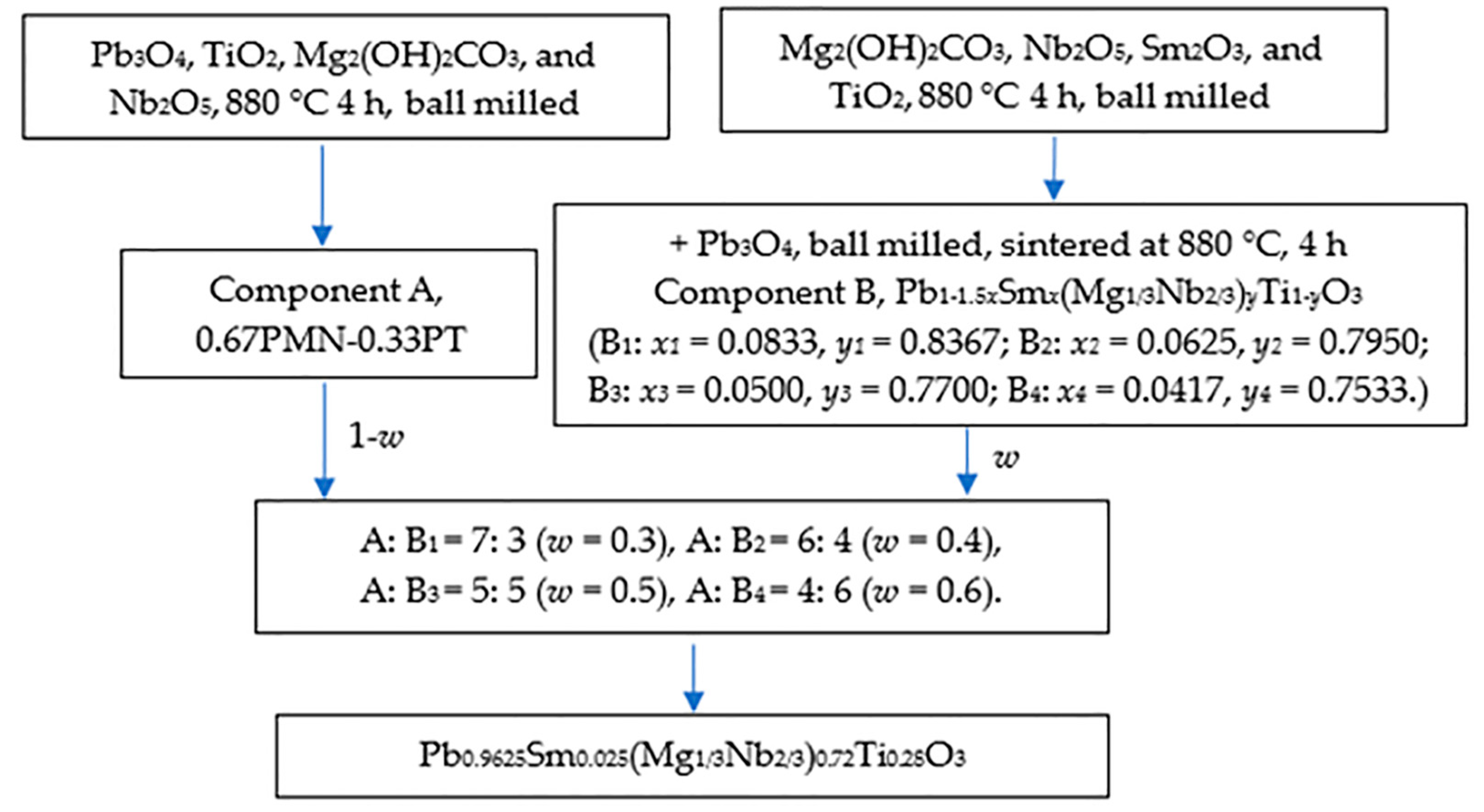
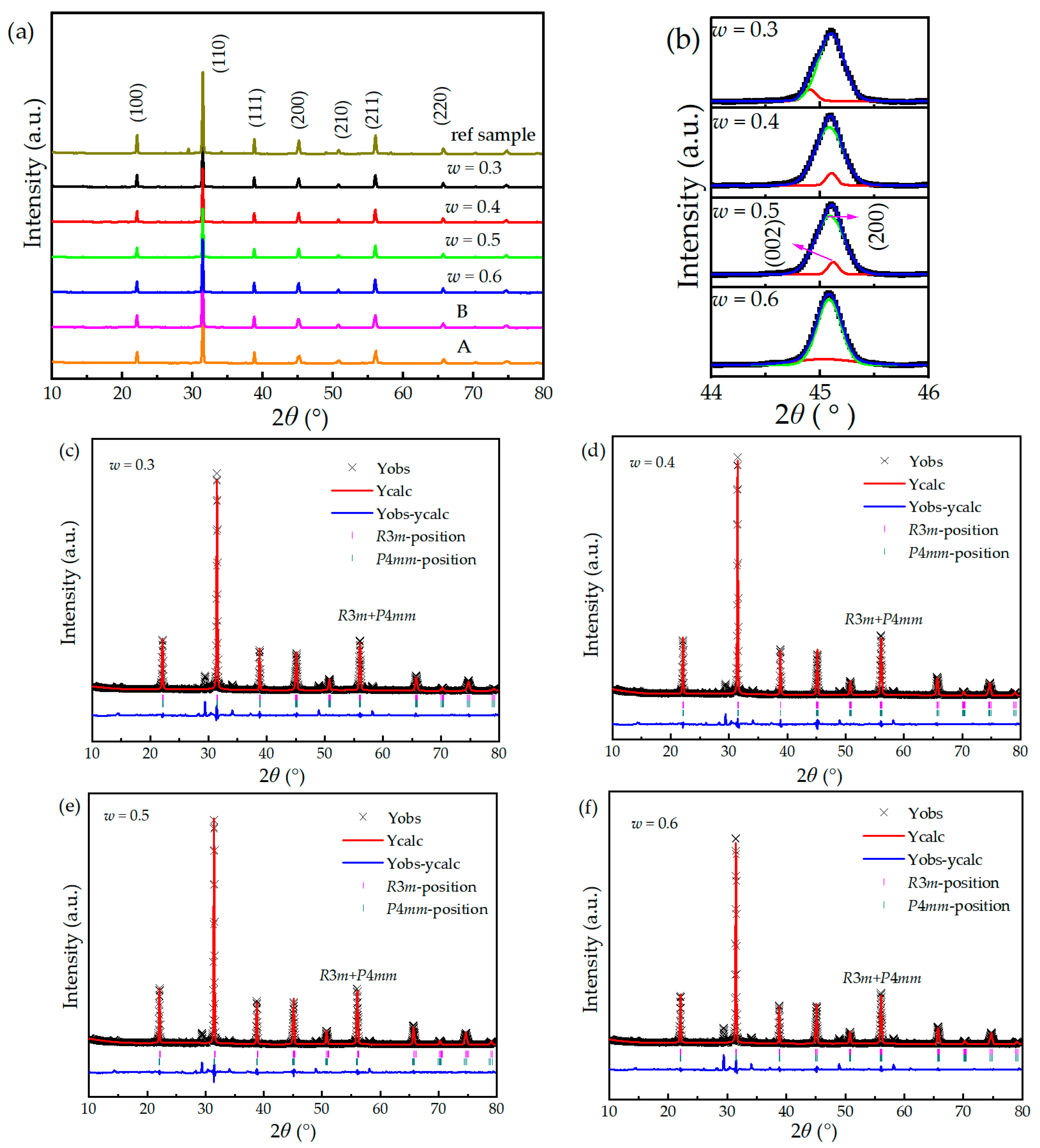
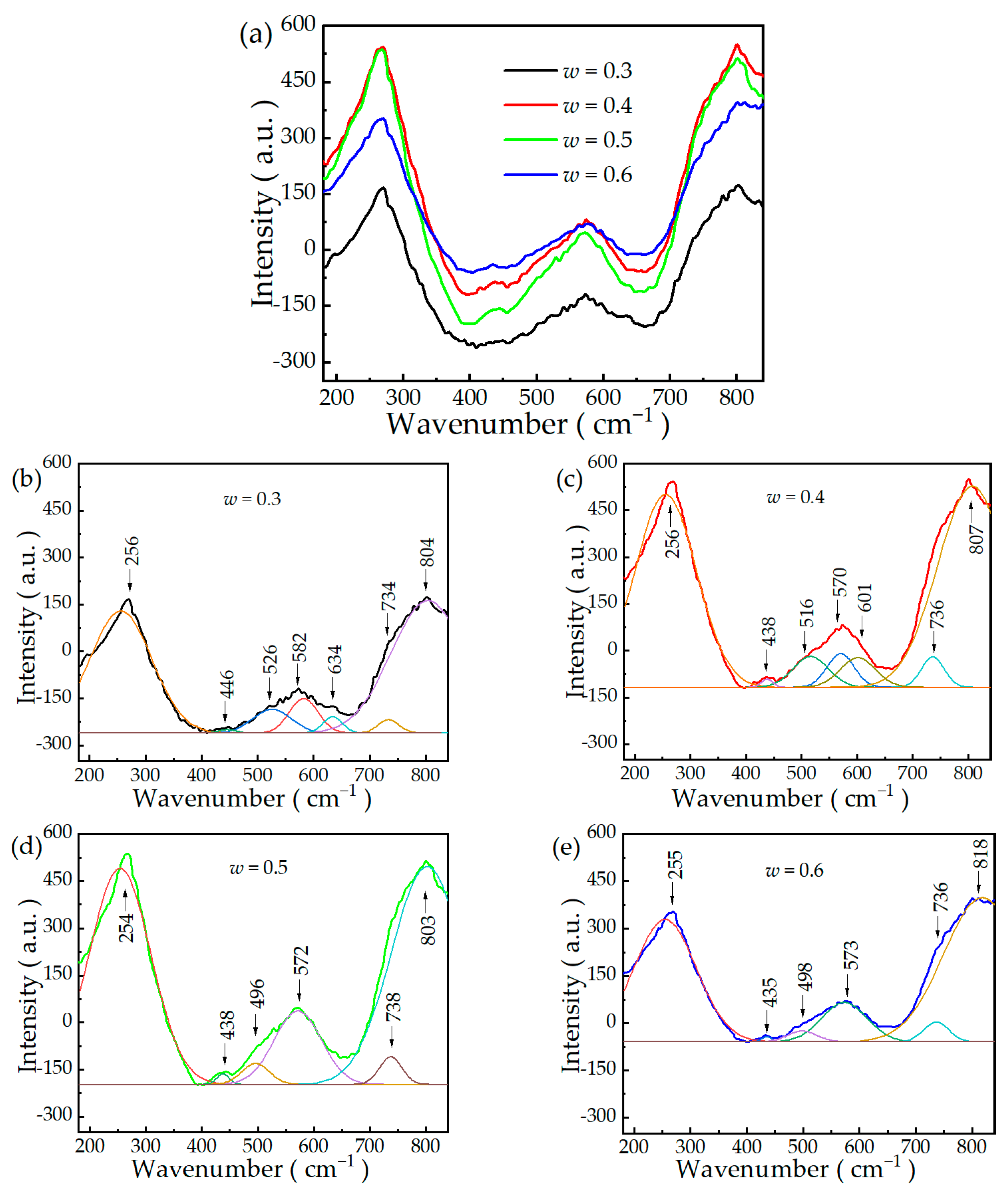
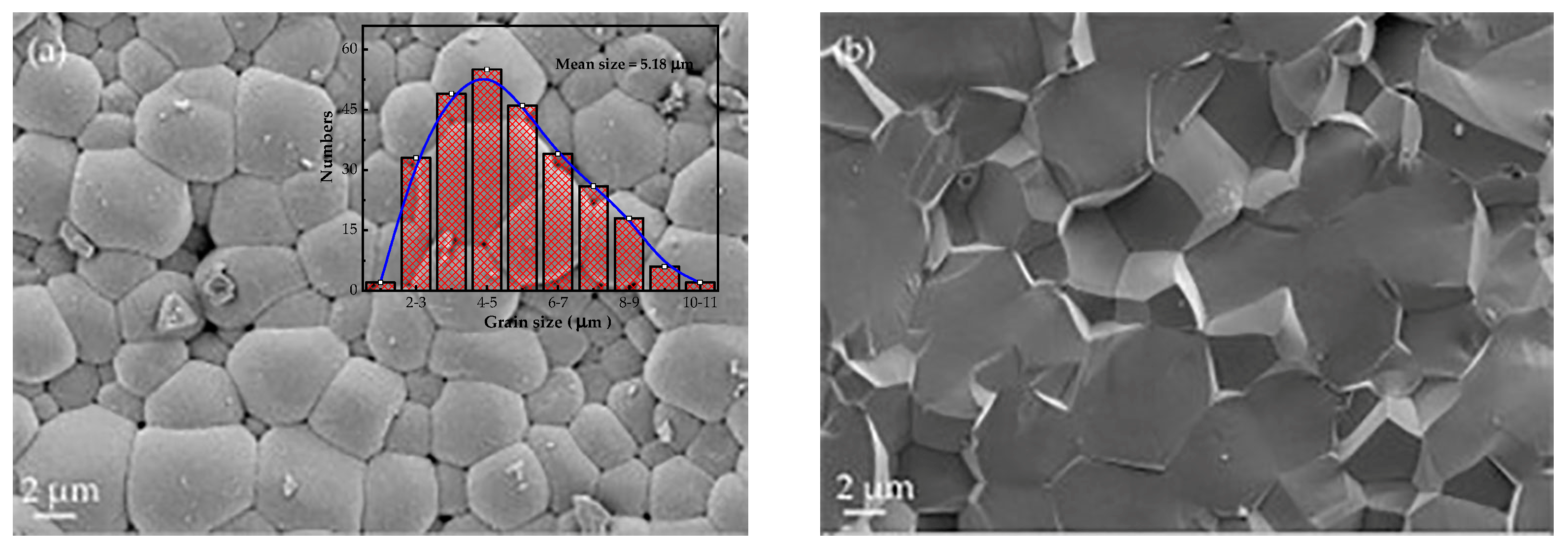
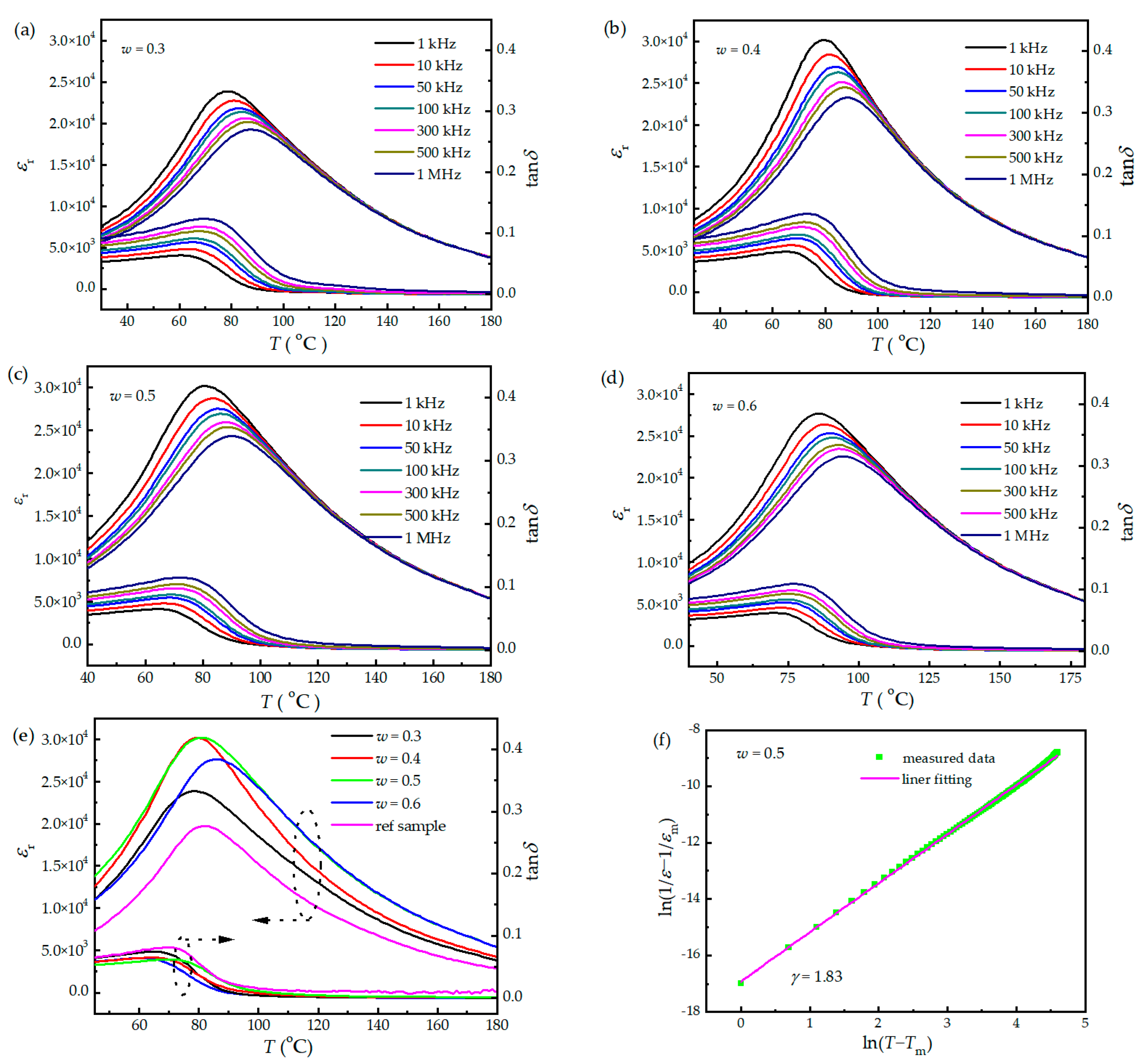

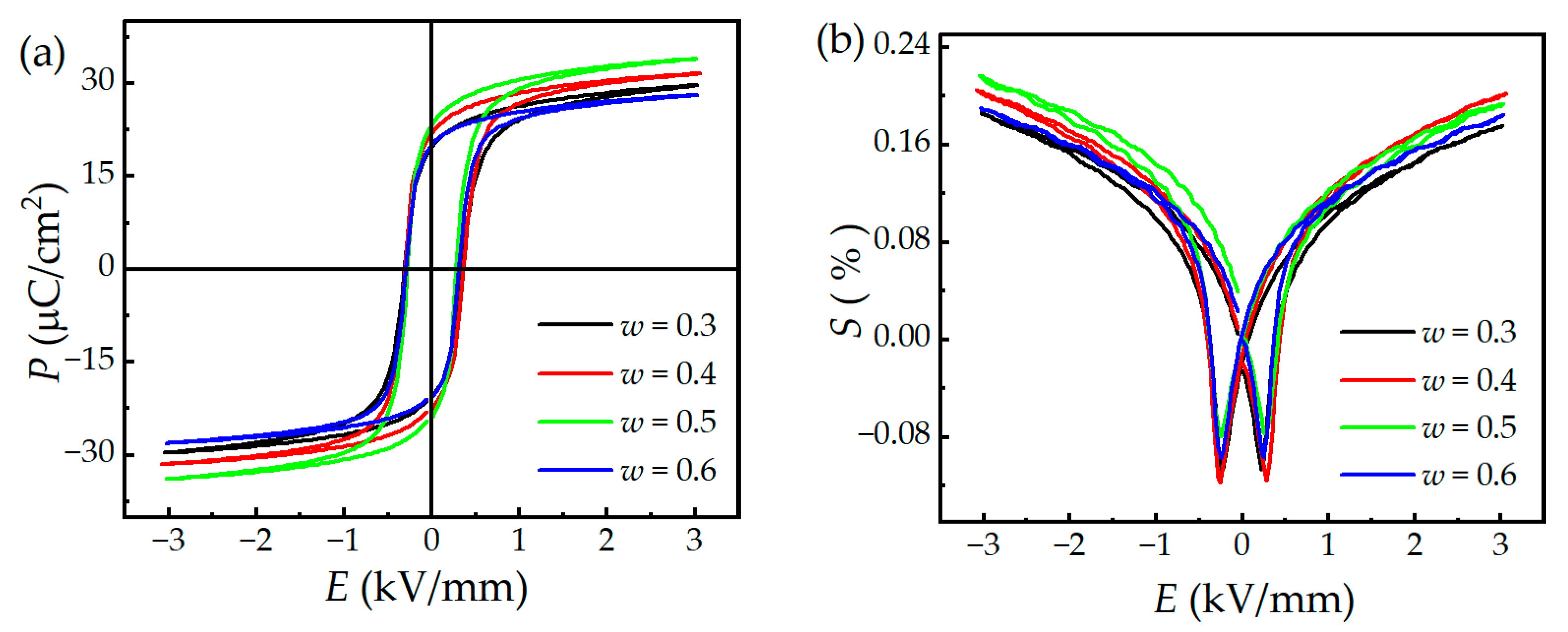
| Sample | Lattice Parameters (Å) Phase 2, P4mm | Lattice Parameters (Å) Phase 2, R3m | Weight Fraction (%) | Fitting Parameters | Density (%) |
|---|---|---|---|---|---|
| w = 0.3 | a = b = 4.0129, c = 4.0275 α = β = γ = 90 volume = 64.8563 c/a = 1.0036 | a = b = c = 4.1628 α = β = γ = 82.5990 volume = 70.479 c/a = 1 | P4mm = 75.44 R3m = 25.56 | χ2 = 11.00 wRp = 0.0866 Rp = 0.0495 | 96.6673 |
| w = 0.4 | a = b = 4.0115, c = 4.0250 α = β = γ = 90 volume = 64.7708 c/a = 1.0034 | a = b = c = 4.0020 α = β = γ = 89.3080 volume = 64.0800 c/a = 1 | P4mm = 64.55 R3m = 35.45 | χ2 = 8.121 wRp = 0.0822 Rp = 0.0522 | 96.9128 |
| w = 0.5 | a = b = 4.0126, c = 4.0243 α = β = γ = 90 volume = 64.7951 c/a = 1.0029 | a = b = c = 3.9872 α = β = γ = 88.1280 volume = 63.290 c/a = 1 | P4mm = 40.98 R3m = 59.0200 | χ2 = 7.2861 wRp = 0.0782 Rp = 0.0506 | 97.8874 |
| w = 0.6 | a = b = 4.0146, c = 4.0279 α = β = γ = 90 volume = 64.9177 c/a = 1.0033 | a = b = c = 4.1650 α = β = γ = 82.7190 volume = 70.6420 c/a = 1 | P4mm = 11.58 R3m = 88.42 | χ2 = 11.85 wRp = 0.0945 Rp = 0.0528 | 95.4639 |
| A | a = b = 4.0143, c = 4.0329 α = β = γ = 90 volume = 64.9886 c/a = 1.0046 | P4mm = 100 | χ2 = 2.7817 wRp = 0.0502 Rp = 0.0411 | 96.2847 | |
| B | a = b = c = 4.025 α = β = γ = 88.5180 volume = 66.488 c/a = 1 | R3m = 100 | χ2 = 3.9104 wRp = 0.0590 Rp = 0.0407 | 95.7749 |
| Sample | d33 (pC/N) | kp | kt | ε33/ε0 | tanδ |
|---|---|---|---|---|---|
| w = 0.3 | 1046 ± 24 | 0.62 ± 0.003 | 0.54 ± 0.004 | 8068 ± 166 | 0.039 |
| w = 0.4 | 1099 ± 23 | 0.65 ± 0.002 | 0.53 ± 0.003 | 8520 ± 159 | 0.041 |
| w = 0.5 | 1103 ± 16 | 0.66 ± 0.002 | 0.53 ± 0.002 | 9154 ± 167 | 0.044 |
| w = 0.6 | 929 ± 22 | 0.64 ± 0.002 | 0.54 ± 0.002 | 7102 ± 165 | 0.037 |
| ref | 850 ± 29 | 0.55 ± 0.004 | 0.42 ± 0.003 | 5631 ± 216 | 0.041 |
Disclaimer/Publisher’s Note: The statements, opinions and data contained in all publications are solely those of the individual author(s) and contributor(s) and not of MDPI and/or the editor(s). MDPI and/or the editor(s) disclaim responsibility for any injury to people or property resulting from any ideas, methods, instructions or products referred to in the content. |
© 2023 by the authors. Licensee MDPI, Basel, Switzerland. This article is an open access article distributed under the terms and conditions of the Creative Commons Attribution (CC BY) license (https://creativecommons.org/licenses/by/4.0/).
Share and Cite
Bao, G.-C.; Shi, D.-L.; Zhang, J.-M.; Yang, F.; Yang, G.; Li, K.; Fang, B.-J.; Lam, K.-H. Samarium-Doped Lead Magnesium Niobate-Lead Titanate Ceramics Fabricated by Sintering the Mixture of Two Different Crystalline Phases. Materials 2023, 16, 6781. https://doi.org/10.3390/ma16206781
Bao G-C, Shi D-L, Zhang J-M, Yang F, Yang G, Li K, Fang B-J, Lam K-H. Samarium-Doped Lead Magnesium Niobate-Lead Titanate Ceramics Fabricated by Sintering the Mixture of Two Different Crystalline Phases. Materials. 2023; 16(20):6781. https://doi.org/10.3390/ma16206781
Chicago/Turabian StyleBao, Guo-Cui, Dong-Liang Shi, Jia-Ming Zhang, Fan Yang, Guang Yang, Kun Li, Bi-Jun Fang, and Kwok-Ho Lam. 2023. "Samarium-Doped Lead Magnesium Niobate-Lead Titanate Ceramics Fabricated by Sintering the Mixture of Two Different Crystalline Phases" Materials 16, no. 20: 6781. https://doi.org/10.3390/ma16206781
APA StyleBao, G.-C., Shi, D.-L., Zhang, J.-M., Yang, F., Yang, G., Li, K., Fang, B.-J., & Lam, K.-H. (2023). Samarium-Doped Lead Magnesium Niobate-Lead Titanate Ceramics Fabricated by Sintering the Mixture of Two Different Crystalline Phases. Materials, 16(20), 6781. https://doi.org/10.3390/ma16206781








